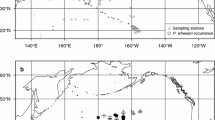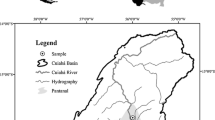Synopsis
The early development of northern logperch, Percina caprodes semifasciata, was examined from an ecological perspective and in relation to the theory of saltatory ontogeny. Steps, the intervals of relative homeostasis, separated by thresholds, rapid switches to new form and function resulting from canalization of changes in the preceeding step, are described and related to environmental factors. Adaptive shifts in growth allometries provided further evidence of the saltatory nature of ontogeny. Logperch eggs are small (1.2 mm diameter), demersal, and adhesive. The simple embryonic respiratory system reflects high oxygen availability on the lotic spawning grounds. Hatching occurs early, relative to other darters, and free embryos are pelagic. The small free embryos presumably drift downstream to lentic areas, where small planktonic food is more abundant. Logperch are therefore nonguarding, open substrate spawning lithopelagophils and, along with other Percina species, have not advanced from ancestral percid reproductive styles. Percina species have generally remained in ancestral habitats-rivers and lakes. The close correlation between developmental patterns of logperch and environmental factors is therefore interpreted as a restriction based on retention of ancestral characteristics, not as evidence of novel adaptations to new habitats.
Similar content being viewed by others
References cited
Balon, E.K. 1975a. Reproductive guilds of fishes: a proposal and definition. J. Fish. Res. Board Can. 32: 821–864.
Balon, E.K. 1975b. Terminology of intervals in fish development. J. Fish. Res. Board Can. 32: 1663–1670.
Balon, E.K. 1979. The theory of saltation and its application in the ontogeny of fishes: steps and thresholds. Env. Biol. Fish. 4: 97–101.
Balon, E.K. 1980. Chapters on the ontogeny of charrs. pp. 485–666, 703–720. In: E.K. Balon (ed.) Charrs: Salmonid Fishes of the Genus Salvelinus, Dr W Junk Publishers. The Hague.
Balon, E.K. 1981a. About processes which cause the evolution of guilds and species. Env. Biol. Fish. 6: 129–138
Balon, E.K. 1981b. Additions and amendments to the classification of reproductive styles in fishes. Env. Biol. Fish. 6: 377–389.
Balon, E.K. 1981c. Saltatory processes and altricial to precocial forms in the ontogeny of fishes. Amer. Zool. 21: 573–596.
Balon, E.K. 1983. Epigenetic mechanisms: reflections on evolutionary processes. Can. J. Fish. Aquat. Sci. 40: 2045–2058.
Balon, E.K. 1984a. Reflections on some decisive events in the early life of fishes. Trans. Amer. Fish. Soc. 113: 178–185.
Balon, E.K. 1984b. The theory of saltatory ontogeny and life history models revisited. Developments in Env. Biol. Fish. (in print).
Balon, E.K. 1984c. Patterns in the evolution of reproductive styles in fishes. pp. 35–53. In: C.W. Potts & R.J. Wootton (ed.) Fish Reproduction: Strategy and Tactics, Academic Press, London.
Balon, E.K. & D.L.G. Noakes. 1980. Principles of ichthyology. 3rd revised edition. Department of Zoology, College of Biological Science, University of Guelph. 285 pp.
Balon, E.K., W.T. Momot & H.A. Regier. 1977. Reproductive guilds of percids: results of the paleogeographical history and ecological succession. J. Fish. Res. Board Can. 34: 1910–1921.
Collette, B.B. & Bănărescu. 1977. Systematics and zoogeography of the fishes of the family Percidae. J. Fish. Res. Board Can. 34: 1450–1463.
Cooper, J.E. 1978. Eggs and larvae of the logperch, Percina caprodes (Rafinesque). Amer. Midl. Nat. 99: 257–269.
Cunningham, J.E.R. 1982. Early ontogeny of Adinia xenica (Cyprinodontiformes, Fundulidae): some patterns and processes of epigenesis. M.Sc. thesis. University of Guelph, Guelph. 198 pp.
Dingerkus, G. & L.D. Uhler. 1977. Enzyme clearing of alcian blue stained whole small vertebrates for demonstration of cartilage. Stain Technol. 52: 229–232.
Disler, N.N. & S.A. Smirnov. 1977. Sensory organs of the lateral-line canal system in two percids and their importance in behavior. J. Fish. Res. Board Can. 34: 1492–1503.
Draper, N.R. & H. Smith. 1981. Applied regression analysis. Second edition. John Wiley & Sons, New York. 709 pp.
Fuiman, L.A. 1983. Growth gradients in fish larvae. J. Fish Biol. 23: 117–123.
Goodrich, E.S. 1958. Studies on the structure and development of vertebrates. 2nd edition. Dover Publications, New York. 837 pp.
Grizzle, J.M. & M.R. Curd. 1978. Posthatching histological development of the digestive system and swim bladder of logperch, Percina caprodes. Copeia 1978: 448–455.
Hodson, P.V. & J.B. Sprague. 1975. Temperature-induced changes in acute toxicity of zinc to Atlantic salmon (Salmo salar). J. Fish. Res. Board Can. 32: 1–10.
Hubbs, C. 1971. Survival of intergroup percid hybrids. Jap. J. Ichthyol. 18: 65–75.
Keast, A. 1980. Food and feeding relationships of young fish in the first weeks after the beginning of exogenous feeding in Lake Opinicon, Ontario. Env. Biol. Fish. 5: 305–314.
Kitchell, J.F., M.G. Johnson, C.K. Minns, K.H. Loftus, L. Creig & C.H. Olver. 1977. Percid habitat: the river analogy. J. Fish. Res. Board Can. 34: 1936–1940.
Koonce, J.F., T.B. Bagenal, R.F. Carline, K.E.F. Hokanson & M. Nagięć. 1977. Factors influencing year-class strength of percids: a summary and model of temperature effects. J. Fish. Res. Board. Can. 34: 1900–1909.
Kryzhanovsky, S.G. 1949. Eco-morphological principles of development among carps, loaches and catfishes. Tr. Inst. Morph. Zhiv. Severtsova 1: 5–332. (In Russian). (Part 2, Ecological groups of fishes and patterns of their distribution, pp. 237–331, Transl. from Russian by Fish. Res. Board Can. Transl. Ser. No. 2945, 1974).
Kryzhanovsky, S.G., N.N. Disler & E.N. Smirnova. 1953. Ecomorphological principles of development in percids. Trudy Inst. Morph. Zhiv. Severtsova 10: 3–138. (In Russian).
Lagler, K.F., J.E. Bardach, R.R. Miller & D.R.M. Passino. 1977. Ichthyology. 2nd edition. John Wiley & Sons, New York. 506 pp.
Løvtrup, S. 1982. The four theories of evolution II. The epigenetic theory. Rivista di Biologia 75: 231–272.
McElman, J.F. 1983. Comparative embryonic ecomorphology and the reproductive guild classification of walleye, Stizostedion vireum, and white sucker, Catostomus commersoni. Copeia 1983: 246–250.
McElman, J.F. & E.K. Balon. 1979. Early ontogeny of walleye, Stizostedion vitreum, with steps of saltatory development. Env. Biol. Fish. 4: 309–348.
McElman, J.F. & E.K. Balon. 1980. Early ontogeny of white sucker, Catostomus commersoni, with steps of saltatory development. Env. Biol. Fish. 5: 191–224.
Page, L.M. 1983. Handbook of darters. T.F.H. Publications, Neptune City. 271 pp.
Paine, M. D. 1984. Ecological and evolutionary consequences of early ontogenies of darters (Etheostomatini). Env. Biol. Fish. 11: 97–106.
Ricker, W.E. 1973. Linear regressions in fishery research. J. Fish. Res. Board Can. 30: 409–434.
Scott, W.B. & E.J. Crossman. 1973. Freshwater fishes of Canada. Fish. Res. Board Can. Bull. 183. 966 pp.
Snedecor, G.W. & W.G. Cochrane. 1967. Statistical methods. 6th edition. Iowa State University Press, Ames. 593 pp.
Strawn, K. & C. Hubbs. 1956. Observations on stripping small fishes for experimental purposes. Copeia 1956: 114–116.
Taylor, W.R. 1967. An enzyme method of clearing and staining small vertebrates. Proc. U.S. Nat. Mus. Washington 122: 1–17.
Trautman, M.B. 1957. The fishes of Ohio. Ohio State University Press, Columbus. 683 pp.
Winn, H.E. 1958a. Observations on the reproductive habits of darters (Pisces-Percidae). Amer. Midl. Nat. 59: 190–212.
Winn, H.E. 1958b. Comparative reproductive behaviour and ecology of fourteen species of darters (Pisces-Percidae). Ecol. Monogr. 28: 155–191.
Author information
Authors and Affiliations
Rights and permissions
About this article
Cite this article
Paine, M.D., Balon, E.K. Early development of the northern logperch, Percina caprodes semifasciata, according to the theory of saltatory ontogeny. Environ Biol Fish 11, 173–190 (1984). https://doi.org/10.1007/BF00000463
Received:
Accepted:
Issue Date:
DOI: https://doi.org/10.1007/BF00000463




